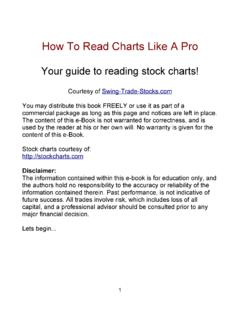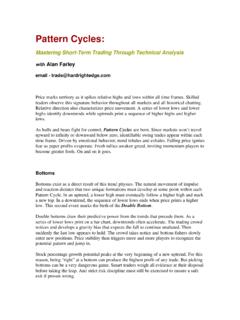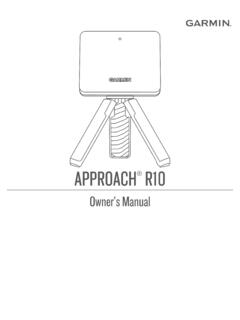Transcription of 3 SWING TRADING EXAMPLES, WITH CHARTS,
1 3 SWING TRADING EXAMPLES, WITH CHARTS, INSTRUCTIONS, AND DEFINITIONS TO GET YOU STARTED By Alan Farley The following examples cover common areas of SWING TRADING that will provide insight into the mechanics of the SWING trade . Following the three examples, I provide a glossary of terms that are essential to understanding the basics of SWING TRADING . I hope the combination will set you on your way to success. (AMZN:Nasdaq) [dated 11/20/01] Net stocks aren't flying very high anymore, but they're still setting up nice SWING trades. After getting pummeled for months, many of these stocks are bouncing off multiyear lows. Driven by optimism that things can't get any worse, market players have finally reawakened the Net rally. But pick your trades wisely. With few exceptions, Net stocks face an extraordinary burden of overhead supply. Vast legions of investors and institutions are still holding these stocks from much higher prices. They will sell out their diminished portfolios for years to come.
2 Many of these stocks are now TRADING in the single digits a situation that demands careful evaluation of position size and risk tolerance. The good news is the massive liquidity and small spreads of the sector's largest stocks. These high-float issues can trade all day with a single penny marking the difference between the buying and selling price. This small transaction cost has another advantage. We can safely juggle in and out of a position several times to catch the best entry price. Most Net rallies are only bear-market bounces. This fact raises the odds that resistance at stocks' 200-day moving averages will extinguish their progress. In fact, the king of the jungle we'll look at today should encounter that gorilla very soon. So play the Net rallies and enjoy the good old days. But keep those stops tight and take what the market gives you. Fortunately, that could be double-digit gains at these discount prices. (AMZN:Nasdaq) got crushed when the bubble burst, losing over 90% of its value.
3 But times may be changing for the online retailer. The last few weeks finally delivered some good news and the stock rallied about 50% off its October low. It now sits just under $10. Not a huge ramp for the former giant, but accumulation suggests a bottom may near. Notice the big move on Nov. 14. It drove Amazon above its 50-day moving average, right into a test of the last high. While volume shows investor interest, Amazon could be headed into a broader basing pattern instead of a breakout. Notice the lines drawn across recent highs and lows. They take on the appearance of a partially developed symmetrical triangle. A stock needs to eject quickly out of a box like this, or it can easily drop all the way back to the lower trend line. The volatility zone between $ and $10 raises another caution flag. As you can see, sharp reversals characterize these price levels. Why does this happen? Certain chart points hide significant numbers of traders and investors sitting in losing positions, because they bought into sudden reversals.
4 This volatility needs to be unwound before price can move past it. The key to this trade is the market number $10. If Amazon can mount it, it will complete two bullish patterns and draw in new buyers. First, it would trigger a cup-and-handle breakout on the shorter-term chart. More importantly, it would confirm a well-formed double bottom on the daily chart. The best TRADING plan might be to go long before the breakout. Consider a position using the intraday pattern, but be prepared to exit quickly if larger forces intercede. For example, a break above the small triangle could offer the perfect entry for a larger price move. But avoid any position near the bottom of this pattern. It has the look of a bearish descending triangle. We could see a decent selloff if that lower line breaks. Concentrate on good trade management if you work this position into a profit. As I mentioned above, strong resistance will stall most bear-market rallies at the 200-day moving average.
5 This formidable barrier is sitting near $12 on Amazon's daily chart. The hot spot also crosses the major down trend line for the entire postbubble collapse. We should take our profits if and when price approaches this danger zone. Nvidia (NVDA:Nasdaq) [dated 12/04/01] Computer gaming has traveled light years since Pong was first released in the 1970s. Fortune 500 companies now cater to a game habit measured in the billions of dollars. In fact, 2001 industry revenue will rival worldwide movie and DVD sales. This time-wasting endeavor has moved well beyond its core teenage audience into a variety of demographics. The game sector also represents an endangered species for traders: a technology bull market. Enthusiastic buyers are loading up on a new generation of boards, boxes and game titles. Equities keep running to catch up with this strong demand, and most stocks sit very close to multiyear highs. You can attempt to profit with trade setups in the gaming sector. But forget about direct plays on the boxmakers themselves.
6 Microsoft (MSFT:Nasdaq) (Xbox) and Sony (SNE:NYSE ADR) (PlayStation 2) have core interests unaffected by industry sales. Japanese giant Nintendo (GameCube) has no ADR (American Depository Receipt) TRADING on the American markets. Nvidia, a boardmaker, is another story, however. Nvidia rose from mediocrity to become the powerhouse in 3-D chips, boards and technology. The Nvidia chipset in Microsoft's Xbox ensures its industry leadership for years to come. Nvidia has been pushing through a series of all-time highs throughout its relationship with Microsoft. But it has never generated very strong momentum after each high and has fallen back over and over again to retest lower ground. What will it take for Nvidia to finally break out of the top of its rising trend line? The volume spike on Nov. 29 might offer a clue. It conceals a false breakout that caught many longs in a bull trap. Until Nvidia can absorb overhead supply created by this ugly reversal, it will be difficult for any rally to generate momentum.
7 Nvidia sits at a price pivot where it could start another run at the short-term high. Or it could just roll over here and retest the $40s. The small Island Reversal formed last week might speed up events. Many traders probably noticed it and entered new short sales. The stock will need to fill the gap and trade above $54 in a hurry, or the shorts (plus overhead supply) could kick in with a vengeance. Alkermes (ALKS:Nasdaq) [dated 11/29/01] At a training session a while ago I asked the crowd about their TRADING habits. Specifically, I wanted to know how often they sold short. To my amazement, less than 25% said they ever had. This was not a group of typical buy-and-hold investors. These were hard-core traders. But even with all that experience, many avoided the art of short-selling. Obscure market rules and Wall Street happy talk discouraged short-selling for years. Furthermore, the upside-down logic required to sell short was too mysterious for many retail traders.
8 Times have changed with the advent of online TRADING and instant execution. Filling a short sale is now just as easy as buying a stock. Gone are the days when you had to plead with your broker to release shares from inventory so you could borrow them. And the SEC is finally giving serious thought to abolishing the uptick rule. Here are three quick tips to improve your odds when selling short: First, never chase a selloff. The best short sales come at the end of weak rallies. Second, sell short in less volatile markets. Tech stocks carry high short interest (outstanding short sales) and are vulnerable to nasty squeezes. Finally, take a short position in a well-established downtrend, rather than trying to pick a top in a rally. Timing a short sale requires more precision than buying a stock for a trade . True believers, contrarian traders and old-fashioned bad luck hold up crappy stocks that should break down. Help your cause by locating bearish patterns on both the daily and 60-minute charts.
9 But even then, keep stops tight and don't hesitate to jump ship if the short trade doesn't move quickly in your favor. SWING traders should recognize Alkermes' (ALKS:Nasdaq) setup from their favorite technical analysis books. It's a classic head-and-shoulders pattern, and it fits all the rules. It has well-formed left and right shoulders at the same height. The neckline descends modestly in a straight line. And each rally shows less commitment by the longs. So the stock appears to be a prime target for short-sellers. In a classic head-and-shoulders setup, we expect a stock to break the neckline and fall a distance equal to the height of the head (middle high). This targets a decline to around $20 for Alkermes. But we have no guarantee the target will be reached, so the setup works best with a trailing stop loss. This way we can grab a profit, but reduce damage from an unexpected short squeeze. The Alkermes chart looks bearish for other reasons as well. The November high failed at the 200-day moving average.
10 And the selloff on the last bar failed the 50-day moving average. So when do we jump in with our short sale? It still looks too early to sell Alkermes short. The 60-minute overbought-oversold oscillator (stochastics) cautions that the stock could bounce before breaking the neckline. Fortunately, a weak rally might offer a better short entry. It would run into triple resistance: the broken 50-day moving average, three short-term lows and a market number of $25. And by that time, stochastics could be rolling over from an overbought condition. All-around better timing for our SWING trade . The classic head-and-shoulders trade sells short on a neckline break or the first pullback, if the opportunity arises. But the pattern is so well known that common entry levels can generate substantial whipsaws. Contrarians like to trade against head-and-shoulders short-sellers, and implement a variety of shakeouts to force them to cover positions. Don't be surprised if price pulls back through the broken neckline before generating good downside momentum.
















